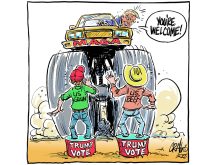Nicholson and Toews are elected directors with the Canadian Wheat Board.
From now until March 13, the farmers of Western Canada will have an opportunity to voice their opinion on the kind of marketing system they would like to have in place for barley.
This vote is taking place as a result of the federal government’s desire to move ahead on its election promise to eliminate the CWB’s single desk powers and to move toward a “marketing choice” environment for western Canadian wheat and barley.
Federal agriculture minister Chuck Strahl has made it clear to everyone willing to listen that this is not a binding vote. It is strictly, in his words, “a consultation.” He has never committed to listening to what farmers have to say on this issue, especially if a majority of us vote in favour of retaining the single desk for barley exports and barley used for human consumption.
Read Also

Finding the sweet spot where ag science meets ag culture
Soon, many will look at practices such as seeding marginal acres to forage, growing cover crops and livestock integration and ask why they didn’t do this sooner.
In the absence of such a commitment, it is quite clear that the vote is simply a stepping stone for the minister and his government, a stepping stone toward marketing choice.
In this sense, it is hardly surprising that the minister has tried to word the barley plebiscite question, not in the clearest way possible, which he publicly stated he would do, but rather in a way that will give him and his government the result they want.
Several provincial farm groups had asked the minister to word the question as a simple either/or proposition. They told him last fall that the only way to get a clear result out of a producer plebiscite was to ask farmers to choose between an open market and the single desk.
Academics have argued, the CWB directors have argued, and in fact the minister’s own task force has clearly stated that you either have a single desk – one agent selling all the wheat and barley from the Prairies – or an open market with a whole host of sellers. A dual market does not exist.
Whether some kind of a modified CWB continues to exist in the open market doesn’t make any difference. Once it is stripped of its single desk powers, its ability to add significant value for farmers is gone.
Therefore, although there are three options on the ballot, there are only two choices. Option 1 would enable the CWB to continue as a viable presence in the grain industry. Options 2 and 3 give the same result: an open market is an open market whether or not some small grain broker that used to be called the CWB is involved.
The government continues to insist that its proposed third option, that of a strong and viable CWB in an open market, is credible. In light of the numerous well documented opinions to the contrary, it is incumbent upon the government to outline how that model would work and how it would add value for farmers.
The federal government and the minister have so far refused to show us the model. The minister prefers to speak in vague terms of the benefits that will result from “marketing freedom.”
This is the same kind of nonsense and gobbledygook that farmers have heard many times before when governments try to weasel out of their commitments to agriculture. The elimination of transportation subsidies (the Crow Benefit, as most people remember it) is the prime example. Take away the Crow, went the senseless drivel, and value-added processing will flourish. Meanwhile harsh reality is that in the intervening decade, prairie farmers have experienced the worst income crisis since the depression era.
The point is that the majority of farmer elected directors who sit on the CWB’s board simply do not buy the minister’s rhetoric. He says that he wants a strong and viable CWB to remain an option to farmers, but we don’t believe him because we have heard all of this before.
If the minister wants to convince us of his intentions and most importantly of the value of the dual market model, he’s going to have to do a lot better than simply throwing it back at us and saying, “here, you figure it out.”
Instead of engaging in constructive dialogue, the minister has systematically tried to undermine the authority and legitimacy of the farmer-elected directors by undertaking unilateral action and using directive powers to advance his government’s political agenda. The past six months have provided lots of examples:
- A roundtable discussion on the CWB’s future in Saskatoon to which the CWB was not invited or informed about.
- A task force stacked with opponents of the single desk that was asked to come up with a road map for its future.
- A gag order to prevent farmer elected directors from spending money the way they see fit.
- Dismissal of a president and CEO who had the board’s full backing and whose integrity was beyond question.
- Negotiation of a salary package with an interim CEO and the use of an order-in-council to force compliance with terms of a contract that we had no hand in drafting.
- An unclear question designed to give the minister the results his government wants.
Not surprisingly, the government’s behaviour toward the CWB has begun to affect how customers, investors and competitors view the CWB. Customers have expressed concern over our long-term viability and whether Canada can be in a position to still meet their grain needs.
With Standard and Poor’s recent downgrading of the CWB’s long-term usurer credit rating, it is clear that the investors are beginning to look with some trepidation at what the government is doing and that they are far from convinced that a “strong and viable” CWB will still be around when the single desk is eliminated.
Competitors like the United States are noting that the government of Canada does not support the single desk, and you can bet that they will be gunning for the elimination of the single desk if and when the World Trade Organization talks start again.
The minister has taken to blaming the CWB for this uncertainty and the impact that it is having on the economic well-being of farmers. He has accused the farmer elected directors of fear-mongering and scare tactics. But he is looking for a way out of the hole he has dug for himself, for farmers and for the grain marketing system.
The fact is that he has created the anxiety that is out there and he has eroded our nation’s reputation as a world class marketer of grain.
Having made his bed, the least he can do now is lie in it.














